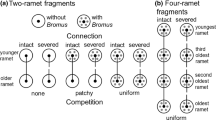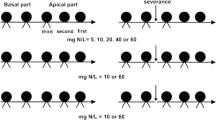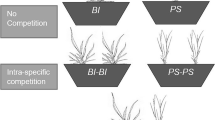Abstract
It has been hypothesized that clonal integration between ramets inenvironments with spatially variable rates of herbivory and nutrientavailabilities leads to increased growth and fitness in the genet. An increasein genet growth could potentially influence ecosystem processes such as primaryproductivity and nutrient cycling. I tested the idea that clonal integrationwould lead to greater aboveground productivity, compensatory response todefoliation, and N re-distribution in a factorial experiment in fieldplots in the Serengeti Ecosystem, Tanzania. Each plot had either all stolonssevered or left intact, had repeated defoliation (to simulate grazing bythe African buffalo) or none, and was either located next to a plot thatreceived urea (to simulate a urine-hit) or next to a plot thatremained untreated. Plots that received stolon severing treatments had32% less peak biomass than did connected control plots, and this suggeststhat plants grew better when ramets remained connected. However, compensatoryresponse by plots to repeated defoliation was inconsistent with the hypothesizedbenefits of ramet integration at the ecosystem level: productivityresponse to defoliation was similar between plots with connected vs. severedramets (i.e. no stolon severing × defoliation interaction wasfound). When averaged across other treatments, defoliated plots hadincreased productivity compared to nondefoliated plots during the growingseason. Thus, ramet connection and defoliation did increase productivity whenthey were considered alone, but productivity response to defoliation wasunaffected by ramet connections. Urea additions, which led to a 78%increase in productivity in adjacent “urine-hits”, had noconsistent effect on productivity but did increase leaf percent N in adjoiningstudy plots. Thus, in the Serengeti, urine hits probably have very localizedeffects on productivity during the initial growing season.
Similar content being viewed by others

References
Alpert P. 1991. Nitrogen sharing among ramets increases clonal growth in Fragaria chiloensis. Ecology 72: 69–80.
Ashman J.W. and Pitelka L.F. 1985. Population biology of Clintonia borealis. II. Survival and growth of transplanted ramets in different environments. J. Ecology 73: 185–198.
Ashmun J.W., Thomas R.J. and Pitelka L.F. 1982. Translocation of photoassimilates between sister ramets in two rhizomatous forest herbs. Ann. Bot. 49: 403–415.
Caraco T. and Kelly C.K. 1991. On the adaptive value of physiological integration in clonal plants. Ecology 72: 81–93.
Day T.A. and Detling J.K. 1990. Grassland and patch dynamics and herbivore grazing preference following urine deposition. Ecology 71: 180–188.
Derner J.D. and Briske D.D. 1998. An isotopic (15N) assessment of intraclonal regulation in C4, perennial grasses: Ramet interdependence, independence, or both? J. Ecology 86: 305–314.
Evans J.P. and Whitney S. 1992. Clonal integration across a salt gradient by a nonhalophyte, Hydrocotyle bonariensis_ (Apiaceae). Am. J. Bot. 79: 1344–1347.
Fahrig L., Coffin D.P., Lauenroth W.K. and Shugart H.H. 1994. The advantage of long-distance clonal spreading in highly disturbed habitats. Evol. Ecology 8: 172–187.
Georgiadis N.J. and McNaughton S.J. 1988. Interactions between grazers and a cyanogenic grass, Cynodon plastostechyus. Oikos 51: 343–350.
Gifford R.M. and Marshall C. 1973. Photosynthesis and assimilate distribution in Lolium multiflorum Lam. following differential defoliation. Austr. J. Biol. Science 26: 517–526.
Harper J.L. 1977. Population Biology of Plants. Academic Press, London.
Hartnett D.C. 1993. Regulation of clonal growth and dynamics of Panicum virgatum (Poaceae) in tallgrass prairie: effects of neighbor removal and nutrient addition. Am. J. Bot. 80: 1114–1120.
Herms D.A. and Mattson W.J. 1992. The dilemma of plants: to grow or defend. Quart. Rev. Biol. 67: 283–335.
Hester M.W., McKee K.L., Burdick D.M., Koch M.S., Flynn K.M., Patterson S. et al. 1994. Clonal integration in Spartina patens across a nitrogen and salinity gradient. Can. J. Bot. 72: 767–770.
Jaramillo V.J. and Detling J.K. 1992a. Small-scale heterogeneity in a semi-arid North American grassland. I. Tillering, N uptake and retranslocation in simulated urine patches. J. Appl. Ecol. 29: 1–8.
Jaramillo V.J. and Detling J.K. 1992b. Small-scale heterogeneity in a semi-arid North American grassland. 2. Cattle grazing of simulated urine patches. J. Appl. Ecol. 29: 9–13.
Jonsdottir I.S. and Callaghan T.V. 1989. Localized defoliation stress and the movement of 14C-photosynthates between tillers of Carex bigelowii. Oikos 54: 211–219.
Marshall C. and Sagar G.R. 1965. The influence of defoliation on the distribution of assimilates in Lolium multiflorum. Lam. Ann. Bot. 29: 365–370.
Marshall C. 1968. The distribution of assimilates in Lolium multi-florum Lam. following differential defoliation. Ann. Bot. 32: 715–719.
Marshall C. 1990. Source-sink relations of interconnected ramets. In: van Groenendael J. and de Kroon H. (eds), Clonal Growth in Plants: Regulation and Function. Academic Publishing, The Hague, The Netherlands, pp. 23–41.
Mattheis P.J., Tieszin L.L. and Lewis M.C. 1976. Responses of Dupontia fischeri to simulated lemming grazing in an Alaskan arctic tundra. Annals of Botany 40: 179–197.
McNaughton S.J. 1977. Diversity and stability of ecological communities: a comment of the role of empiricism in ecology. American Naturalist 111: 515–525.
McNaughton S.J. 1978. Serengeti ungulates: feeding selectivity influences the effectiveness of plant defense guilds. Science 199: 806–807.
McNaughton S.J. 1979. Grazing as an optimization process: grass-ungulate relationships in the Serengeti. Am. Nat. 113: 691–703.
McNaughton S.J. 1983. Serengeti grassland ecology: the role of composite environmental factors and contingency in community organization. Ecology 53: 291–320.
McNaughton S.J. 1985. Ecology of a grazing ecosystem: the Serengeti. Ecol. Monogr. 55: 259–294.
McNaughton S.J. 1989. Interactions of plants of the field layer with large herbivores. Symp. Zool. Soc. Lond. 61: 15–29.
McNaughton S.J., Milchunas D.G. and Frank D.A. 1996. How can net primary productivity be measured in grazing ecosystems? Ecology 77: 974–977.
Milchunas D.G. and Lauenroth W.K. 1993. Quantitative effects of grazing on vegetation and soils over a global range of environments. Ecological Monographs 63: 327–366.
Nueter J., Wasserman W. and Kutner M.H. 1985. Applied Linear Statistical Models. Richard D. Irwin, Inc., Homewood, Illinois.
Oesterheld M. and McNaughton S.J. 1991. Effect of stress and time for recovery on the amount of compensatory growth after grazing. Oecologia 85: 305–313.
Pitelka L.F. and Ashmun J.W. 1985. Physiology and integration of ramets in clonal plants. In: Jackson J.B., Buss L.W. and Cook R.F. (eds), Population Biology and Evolution of Clonal Organisms. Yale Univ. Press, New Haven, London, pp. 399–437.
Potvin C., Lechowicz M.J. and Tadiff S. 1990. The statistical analysis of ecophysiological response curves obtained from experiments involving repeated measures. Ecology 71: 1389–1400.
Price E.A.C. and Hutchings M.J. 1992. Studies of growth in the clonal herb Glechoma hederacea. II. The effects of selective defoliation. J. Ecol. 80: 39–47.
Ruess R.W. and McNaughton S.J. 1988. Ammonia volatilization and the effects of large grazing mammals on nutrient loss from East African grasslands. Oecologia 77: 382–386.
Schmid B., Puttick G.M., Burgess K.H. and Bazzaz F.A. 1988. Clonal integration and effects of simulated herbivory in old-field perennial. Oecologia 75: 465–471.
Schmid B., Miao S.L. and Bazzaz F.A. 1990. Effects of simulated root herbivory and fertilizer application on growth and biomass allocation in the clonal perennial Solidago canadensis. Oecologia 84: 9–15.
Sinclair A.R.E. 1977. The African Buffalo. University of Chicago Press.
Sinclair A.R.E. and Norton-Griffiths M. 1979. Serengeti: Dynamics of an Ecosystem. Univ. Chicago Press, Chicago.
Steel R.G.D. and Torrie J.H. 1980. Principles and Procedures of Statistics: A Biometric Approach. McGraw-Hill Book Co., New York.
Stuefer J.F. and Hutchings M.J. 1994. Environmental heterogeneity and clonal growth: a study of the capacity for reciprocal translocation in Glechoma hederacea L. Oecologia 100: 302–308.
Stuefer J.F., During H.J. and de Kroon H. 1994. High benefits of clonal integration in two stoloniferous species, in response to heterogenous light environments. J. Ecol. 82: 511–518.
Tolvanen A. 1994. Differences in recovery between a deciduous and an evergreen ericaceous clonal dwarf shrub after simulated aboveground herbivory and belowground damage. Can. J. Bot. 72: 853–859.
Watson M.A. and Casper B.B. 1984. Morphogenetic constraints on patterns of carbon distribution in plants. Ann. Rev. Ecol. Syst. 15: 233–258.
Welker J.M. and Briske D.D. 1992. Clonal biology of temperate, caespitose, graminoid Schizachyrium scoparum: a synthesis with reference to climate change. Oikos 63: 357–365.
Welker J.M., Briske D.D. and Weaver R.W. 1987. Nitrogen-15 partitioning within a three generation tiller sequence of the bunchgrass Schizachyrium scoparium: response to selective defoliation. Oecologia 74: 330–334.
Welker J.M., Rykiel E.J., Briske D.D. and Goeschl J.D. 1985. Carbon import among vegetative tillers within two buchgrasses: assessment with carbon-11 labelling. Oecologia 67: 209–212.
Wijesinghe D.K. and Handel S.N. 1994. Advantages of clonal growth in heterogeneous habitats: an experiment with Potentilla simplex. J. Ecol. 82: 495–502.
Wilsey B.J., Coleman J.S. and McNaughton S.J. 1994. Will increases in atmospheric CO2 affect regrowth following grazing in C4 grasses from tropical grasslands? A test with Sporobolus kentrophyllus. Oecologia 99: 141–144.
Wilsey B.J. 1996. Urea additions and defoliation affect plant responses to elevated CO2 in a C3 grass from Yellowstone National Park. Oecologia 108: 321–328.
Author information
Authors and Affiliations
Rights and permissions
About this article
Cite this article
Wilsey, B. Clonal plants in a spatially heterogeneous environment: effects of integration on Serengeti grassland response to defoliation and urine-hits from grazing mammals. Plant Ecology 159, 15–22 (2002). https://doi.org/10.1023/A:1015556816307
Issue Date:
DOI: https://doi.org/10.1023/A:1015556816307



